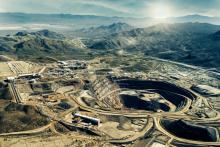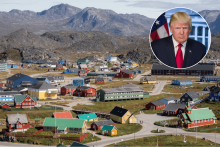Eclipse Metals' ongoing interrogation of the data across its historical Ivittuut cryolite mine in Greenland is revealing a wealth of potential out-wide production opportunities, including high-purity silica for use in a range of existing and emerging technologies. Modelling of the rich ore system shows a distinct silica-rich core to the Ivittuut intrusion, with historical drill holes returning wide quartz-rich intercepts grading at over 97 per cent silica.


Eclipse Metals' is on a roll in southern Greenland with an ongoing interrogation of the historical data across its Ivittuut cryolite mine revealing a wealth of out-wide potential production opportunities, including high-purity silica for use in a range of emerging technologies. The company says modelling of the ore system shows a distinct silica-rich core to the Ivittuut intrusion, with historical drill holes returning wide, quartz-rich intercepts grading at over 97 per cent silica.
Whilst the Ivittuut mine was originally exploited for cryolite, a specialist mineral used in the production of alumina, Eclipse remains firmly interested in its remaining cryolite endowment. However, the Perth based company is also looking for other mineral opportunities, given the deposit’s neat zonation of different minerals.
The company says the additional minerals present at Ivittuut can be characterised into three distinct domains.
Domain One lies in the bottom of the open pit and hosts a blend of cryolite and fluorite mineralisation, whilst Domain Two wraps around Domain One and consists of a sideritic iron ore with a welcome zinc metal credit. Underlying the upper domains is a distinct plug of high-purity quartz, modelled as Domain Three.
Domain Three is thus far only defined by 18 diamond holes, however modelling of the quartz-silica core indicates the geological unit extends laterally over more than 220 metres in width and has a thickness exceeding 90m. The company’s geological expert, North Atlantic Mining Consultants, has proposed a significant exploration target for Domain Three, which tips the scales at 5.70 to 5.94 million tonnes grading at between 90 to 95 per cent silica oxide.
Eclipse says the silica deposit below Ivittuut represents a lucrative commercial opportunity, with the market for silica products currently growing at around 7 per cent per annum and the appetite for the product in the nearby European market exceeds 30 million tonnes per annum of which 15 million tonnes is used in the manufacture of glass products.
The company says the value of the global market in silica oxide products is set to grow to more than $13.5 billion per annum by 2026.
Eclipse Metals Executive Chairman, Carl Popal said: “To date, evaluation of historical data has unveiled massive economic potential for the Ivittuut project being the world’s only known commercial cryolite mine. It also has the potential for multi-commodity deposits of cryolite, fluorite, zinc, iron, high grade quartz and highly sought after rare earth minerals (REE).
“This is a global leap forward for the Company to expand its interests with a unique opportunity to contribute to the growing demand for high-grade silica in the European market.
“Logistically, the deposits are located in close proximity to an existing port, offering significant commercial benefits in the delivery of its products to market.”
Interestingly, silica products fetch a range of prices depending on their relative purities, especially their iron content. Lower quality powders, used in the manufacture of glass, optic fibre and lighting generally trade at between US$1,000 and US$1,500 per tonne, whilst high-purity “Grade 3” silica products command prices of up to a whopping US$19,000 a tonne.
Eclipse’s Ivittuut project is located in south-west Greenland and is situated 375km south of the capital of Nuuk in the Cape Desolation region. The project lies within a mineral province that is famous for its endowment in specialty metals which include rare earth elements, tantalum, niobium, uranium and zirconium to name just a few, most of which are rapidly finding a place on many developed countries “critical minerals” lists.
Ivittuut is covered by a single granted exploration lease which extends over 43 square kilometres of the richly mineralised terrane. The lease takes in the dormant Ivittuut mine in the east and the Gronnedal-aka carbonatite complex in the north. Curiously, the Gronnedal-aka complex has the potential to host significant accumulations of rare earth elements, or “REE’s” and represents an enticing secondary target for the company.
Eclipse’s preliminary assessment of the geological database shows the Ivittuut deposit is associated with a distinct leucogranitic intrusion which hosts a wealth of high-value specialty minerals, including cryolite which was the mainstay of the operation for over a century before the mine closed in 1987.
However, a new moon appears to be rising at Ivittuut with the identification of high-purity silica below the existing open pit and the growing potential of REE mineralisation within the ore system.
Whilst it is still early days in Eclipse’s evaluation of the Ivittuut ore body, historical drill holes boasting intercepts of 54m at 97.6 per cent silica bode well for the potential manufacture of high-grade silica products for delivery into the rapidly expanding technology markets in Europe.
Is your ASX-listed company doing something interesting? Contact: matt.birney@businessnews.com.au











